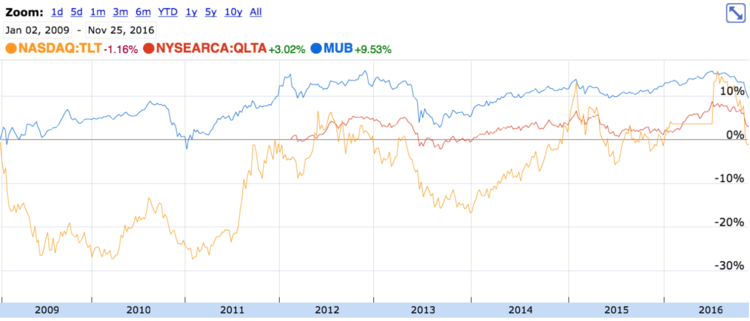
Municipal bonds have outperformed both Treasury and highly rated corporate bonds since the 2008-09 Great Recession. Since they’re backed by taxpayer dollars, investors relied on the asset class as a safe haven during the economic downturn. One cause of concern has been the possibility of rising interest rates, but history tells us that returns are likely to remain positive in the long term.
In this article, we’ll look at the reasons behind muni bonds’ outperformance and whether investors should patiently consider them over longer time frames.
A Historical Perspective of Muni Bond Outperformance
From January 2, 2009 to November 25, 2016, iShares S&P National AMT Free Muni Bond Fund (MUB) gained 9.5% compared to just 3% for the iShares Aaa-A Rated Corporate Bond ETF (QLTA) and a 1.1% loss for the iShares 20+ Year Treasury Bond ETF (TLT).

There are several factors that contributed to this outperformance, including unique tax advantages, high credit quality and low correlation with the equity markets. A combination of these factors made muni bonds a safe-haven asset class throughout the economic downturn when equities and bonds moved lower. Therefore, an investor could have actually generated better returns during this time frame by staying invested in muni bonds compared to corporate bonds and equities.
On a side note, it’s imperative that investors be cautious about the following factors, given the recent presidential election:
- Possibility of slowing capital inflows as inflation returns to the economy, forcing the Federal Reserve to hike interest rates.
- Rising infrastructure spending that could increase muni bond supply and depress prices further.
Effect of Monetary Policy Across the Muni Yield Curve
Many bond investors fear that rising interest rates could hurt municipal bonds, since higher yields translate to lower prices. While knee-jerk reactions are to be expected, a Nuveen analysis of three rising rate periods found that total returns were positive across six benchmark maturities in all three periods. Muni bondholders who stay the course tend to be rewarded when it comes to generating positive returns.
Monetary policy influences short-term interest rates, while inflation expectations govern long-term interest rates. Rising inflation expectations lead to a steeper yield curve as the spread between short- and long-term yields increases. In contrast, lower inflation expectations lead to a flattening yield curve as short- and long-term yields converge. Monetary policy directly influences short-term yields and represents a signal for long-term yields.
Muni bond yield curves tend to flatten with the yields of short-term bonds rising more quickly than those of long-term bonds after a rate hike, according to the Nuveen analysis of three rising rate periods in 1994, 1999, and 2004. Short-term bonds tended to outperform during the actual tightening periods in 1994 and 1999, but they underperformed during the last Fed funds rate hike because intermediate- and long-term bonds already had higher yields.
Nuveen’s analysis shows that staying invested over the long run generates positive total return without having to deal with actively monitoring the market and speculating on reactions.
Flexible Muni Bond Strategy for Longer Investment Horizons
Muni bond investors who hold bonds until maturity will never lose money, unless the bond happens to default. The problem arises when an investor tries to replace the bond. If the investor buys a new bond when rates are low, they are stuck with the bond’s low yields if interest rates were to rise or would incur a capital loss if they were to sell at a lower price.
Bond laddering is a common strategy that can be used to address these concerns and to mitigate the impact of interest rates over time. For example, an investor created a bond ladder as shown below.
| Name | CUSIP | Coupon | Maturity |
|---|---|---|---|
| Tobacco Settlement Financing Corporation Virginia | 88880NAU3 | 5.00% | June 1, 2047 |
| Folsom California Redevelopment Agency Taxable Housing | 344395EV6 | 9.50% | August 1, 2035 |
| Miami Dade Florida Special Obligation | 59333NYM9 | 5.00% | October 1, 2026 |
| New Jersey Health Care Facilities | 64579F4X8 | 4.00% | July 1, 2019 |
| Erie County New York Fiscal Stability Sales Tax | 29508REL6 | 5.00% | December 1, 2017 |
This strategy can be used to hold several bonds at different maturities to diversify across the yield curve. If interest rates start to rise, investors will be able to replace short-term maturities with higher yielding bonds as they mature. Long-term bonds also provide protection in the event that interest rates fall by offering a long-term higher yield. In essence, laddering lets investors rebalance their bond portfolios to mitigate interest rate risks over time.
To explore muni bond trades, you can check our Market Activity section here.
The Bottom Line
Municipal bonds tend to perform well in all kinds of markets, which makes them an attractive asset class. Investors should try to avoid the herd mentality, understand the impact of interest rates and select the right strategy to mitigate those risks.
To keep up to date with the latest municipal bonds, visit the MunicipalBonds.com’s Education Center.






